Waikoloa Village
Story Written by Rick Archer
November 2012
Waikoloa Village
is a luxurious Hilton resort located on Hawaii's Big Island.
It is
25 miles north of Kona on the Kohala Coast. At 62
acres, it covers an enormous area the size of nearly 60
football fields laid side by side.
Waikoloa Village
is known for its lush foliage, wonderful view of the ocean,
and its beautiful system of interlocking swimming pools and
lagoons.
What makes
Waikoloa interesting is that the resort represents a great
human triumph over the cruelty of nature. Behind its
incredible beauty, Waikoloa has a secret. Waikoloa
Village was built right on top of a lava field!
Just 30 miles in the distance, the enormous dormant volcano
Mauna Kea looms over the resort like an ancient sleeping monster.
Waikoloa was
built right on top of the path the burning lava once took on
its way to the ocean.
|
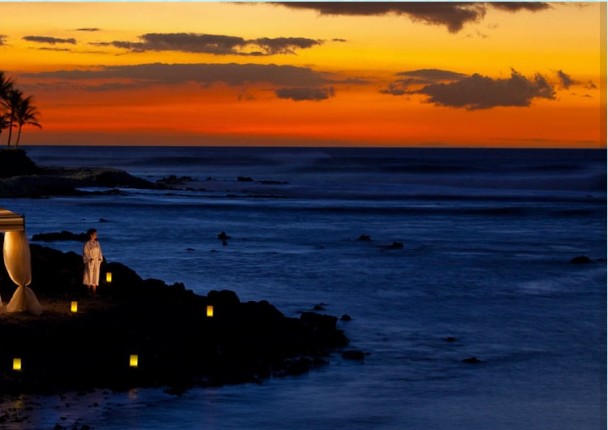 |
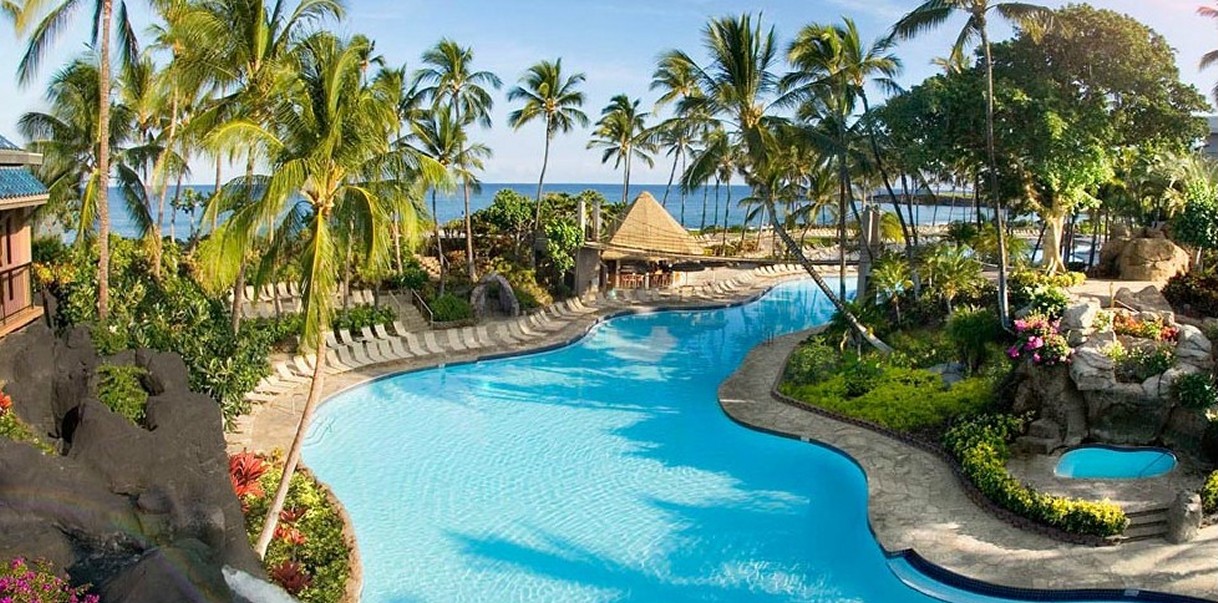
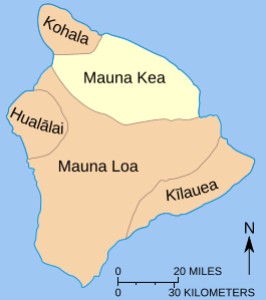 |
Marla and I took the
group to Hawaii once before in 2007. Out of 26 cruise trips,
Hawaii remains Marla's favorite trip of all. Although I have a passion for the Barcelona trip as my
favorite, Hawaii is a close second. Hawaii is without a doubt
the most beautiful area I have ever visited.
There are five
volcanoes on the Big Island.
Kohala and Hualalai are
extinct. Mauna Kea is dormant. Kilauea,
the baby at 300,000-600,000 years, is an emerging volcano.
Although Kilauea is the new star, Mauna Loa is
still definitely active. Mauna Loa's
recent eruptions in 1984 and 1990 decimated an area you will be able
to visit. Many beautiful oceanside homes were
destroyed and vast forests were ruined by the lava flow.
The damage is still very much in evidence. Today the
landscape is so ugly and barren it reminds you of pictures
from the Moon or from Mars.
When our group
visits Hawaii on September 29, 2013, we will spend two days
at the Big Island. The first day we will dock at
Hilo. This will give everyone an opportunity to tour
the amazing Volcanoes National Park. If you
visit this spectacular site, I have one suggestion - pay
attention to where you are stepping. Otherwise you
might lose a foot.
|
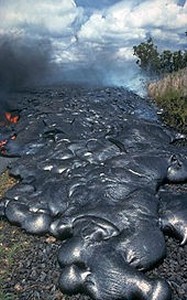 |
|
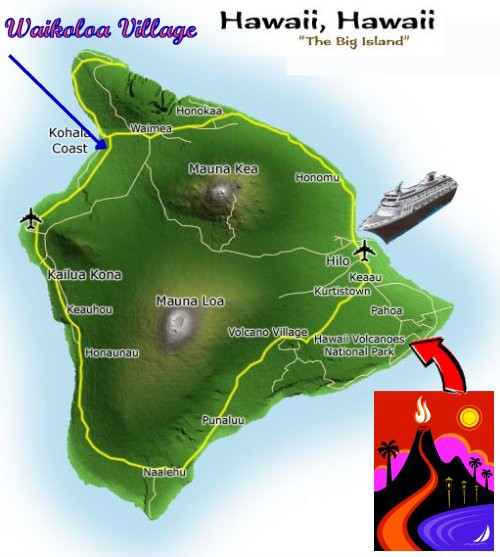 |
As it turns out,
the Mauna Loa lava field you will visit is still active.
New lava is forming all the time. The
danger is that the new lava is just one shade of grey
different than the solidified lava. I would say I came
within three feet of learning this lesson the hard
way.
On the day when
Marla and I visited the desolate area created by the 1984
eruption, I wasn't paying very good attention. They
warned us to watch where we stepped, but I was too busy
playing a computer chess game to bother listening. I
was back on the bus amusing myself.
Consequently I had no
idea there are active lava pockets in the places you will
visit. I was actually headed right towards a danger
area when one of the guides warned me to stop immediately or
lose a foot. True story.
You can read it here
- Rick's Visit to the Volcano
Field
Before I forget,
I need to explain that "Hawaii" is actually the official
name for the Big Island and for the State itself.
Notice in the picture where it says "Hawaii, Hawaii".
In other words, Hawaii is the official name
for the group of eight islands that make up the state of
Hawaii and also for this island specifically. I don't know what caused this mix-up.
However, to avoid confusion, most people simply call this
place "The Big Island".
After our day in
Hilo, that evening our ship will circle towards the south.
During the night we will be treated to the
spectacular sight of the active volcano Kilauea as it spills
red hot lava into the ocean. As you watch the red lava
flowing to the sea, you will gasp in delight. The lava
flow lights up the night. It is quite a
display, definitely one of the highlights of
the trip.
On the following
day, September 30, our ship will dock on the other side of
the island in Kona.
Although there are many excursions to choose from, Marla and
I plan to visit Waikoloa Village and spend the day
hiking through its vast array of lush gardens.
|
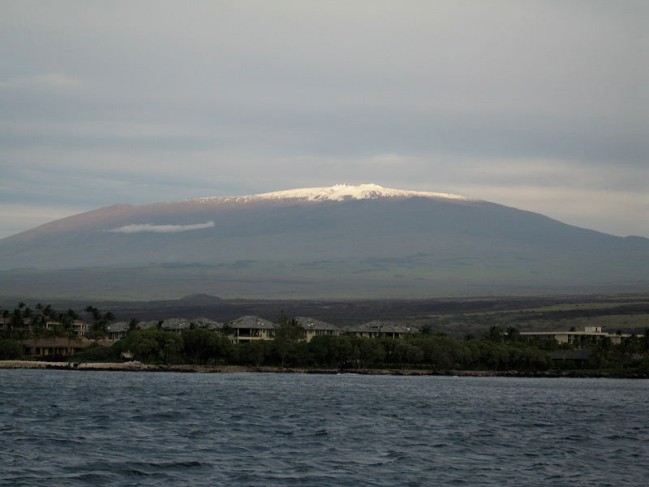 |
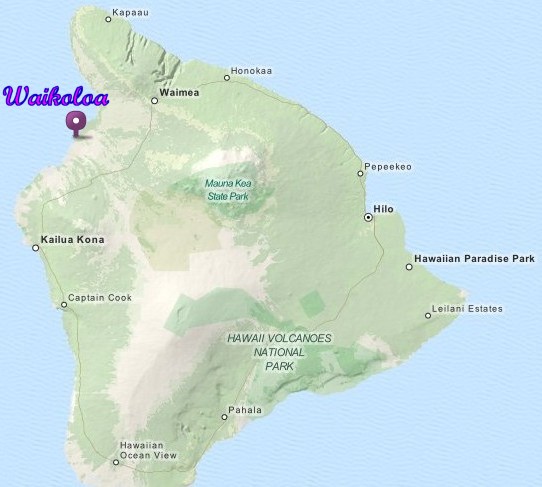 |
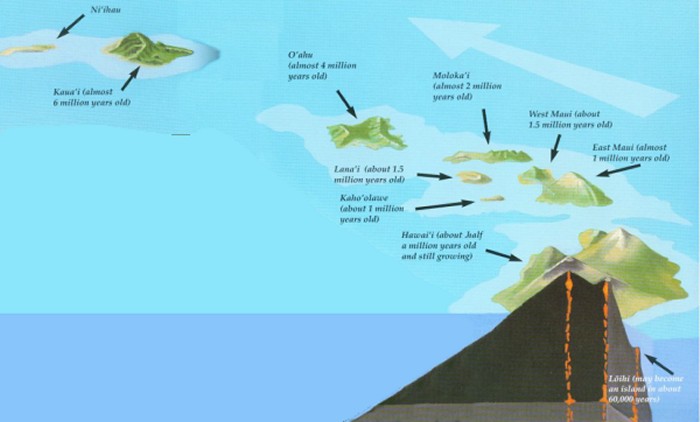 |
Mauna Kea towers over Waikoloa
Village. It can be easily seen 30
miles in the distance. This giant menace
stands as a grim reminder of its violent
past. You assume the volcano is sleeping, but you never know...
Mauna Kea is not "extinct", but rather "dormant". Let
us hope the sleeping giant doesn't wake up any time soon.
If you like
volcanoes, you will love the Big Island. The Big Island is
Hawaii's newest island. It's amazing
to realize that the Big Island is still
"growing". It turns out there is a Hot Spot
down in the ocean floor. It is this Hot Spot that created
each Hawaiian island until they drifted away.
Due to a phenomenon known
as Continental Drift, the Big Island is actually
slowly moving
towards Japan. However, I wouldn't worry about the cruise ship having
trouble finding the islands. The rate of the drift is
perhaps an inch per year.
If you look at the islands using Google
Earth, you will see an entire string of
Hawaiian islands. Each island was once
stationed over the Hot Spot.
|
|
|
The Hot Spot
stays put and the ocean floor moves over it like a conveyor
belt. Hot Spot lava has punched up through the
ocean floor repeatedly, each time at a new spot as the ocean
floor moves above. This forms new islands.
The Hot Spot is
about 50 miles in circumference. It keeps two
volcanoes about 25 miles apart active at a time. Mauna
Loa is at the distant edge while Kilauea,
the 5th volcano to hit the Hot Spot, is right on the center.
A 6th volcano, Lōihi,
is beginning to stir. Loihi is underwater about 22 miles
southeast of the Big Island. It is due to appear above
water in 10,000 years and begin making the newest Hawaiian
island.
As the Big
Island moves, once a volcano is no longer over the "Hot
Spot", it goes dormant, then extinct like
Kohala and Hualalai. Mauna Kea's day is over
and Mauna Loa's days are numbered.
I
previously
wrote about this process in great detail - the
Hot Spot phenomenon.
Here is a
picture of the lagoon at Waikoloa. When you see how
lush and fertile the grounds of this resort are, it is
unimaginable to think this entire area was recently
wasteland created by Mauna Kea's devastation
eons ago.
Believe it or not,
just thirty
years ago this entire area was still a barren
desert of black lava rock. The two pictures below tell
the story. The dark area is lava. The green area is a
Waikoloa golf course built on top of the lava.
|
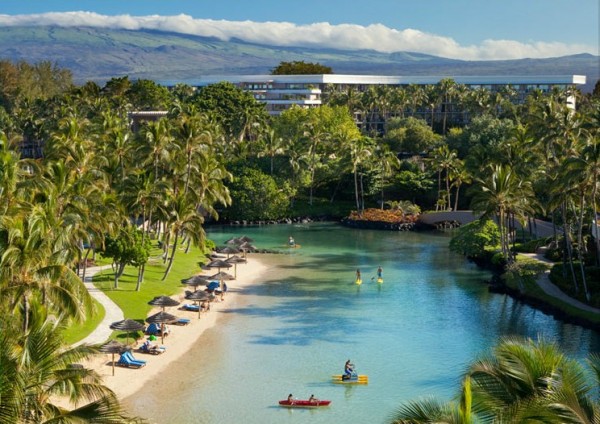 |
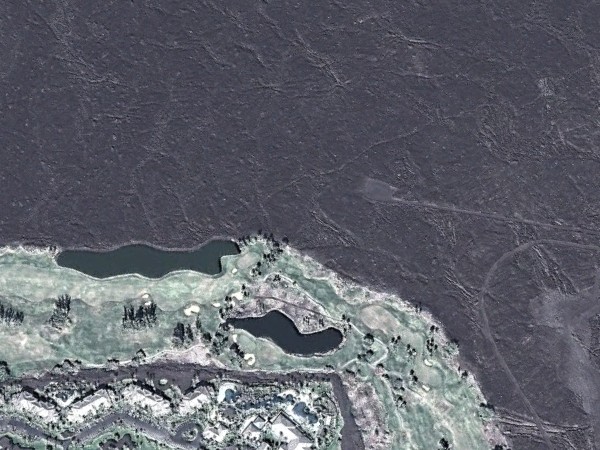 |
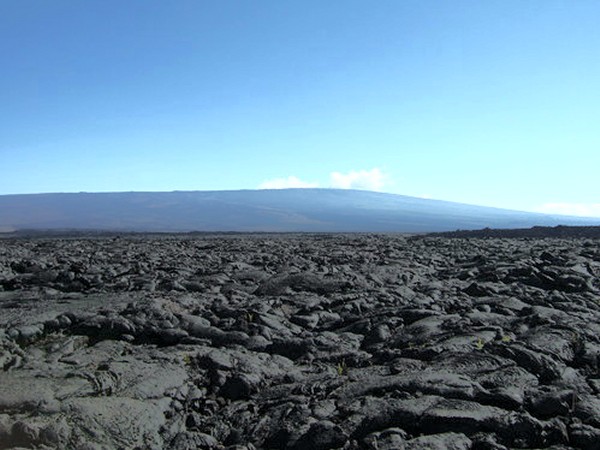 |
Using Google
Earth, an aerial view of the area shows vast areas of brown, grey
and dark grey surrounding the coast line. Those dark areas
are hardened
lava fields created by nearby Mauna Kea. Wikipedia
says it has been 4,600 years
since Mauna Kea last erupted.
To me, it seems
like forests would have regenerated after four thousand years. I would think in
all that time more vegetation would have had time to
develop, but apparently not. I tried to find the
rate of nature reclaiming lava fields but
found no statistics to help.
I think
a major part of the problem is that this area is very arid.
There is little rainfall here. The only thing that
grows is some wispy brush and that's it.
A look at the
countryside surrounding Waikoloa shows nothing on all sides but barren
landscape. Using Google Earth, the only trees I could
find in this area showed up alongside the
stream beds that carry rainwater from Mauna Kea out to the ocean.
So I guess the absence of water is the problem.
The three
pictures below depict the surrounding countryside.
Note the stark contrast of the green land side by side to
the lava field in the third photo.
|
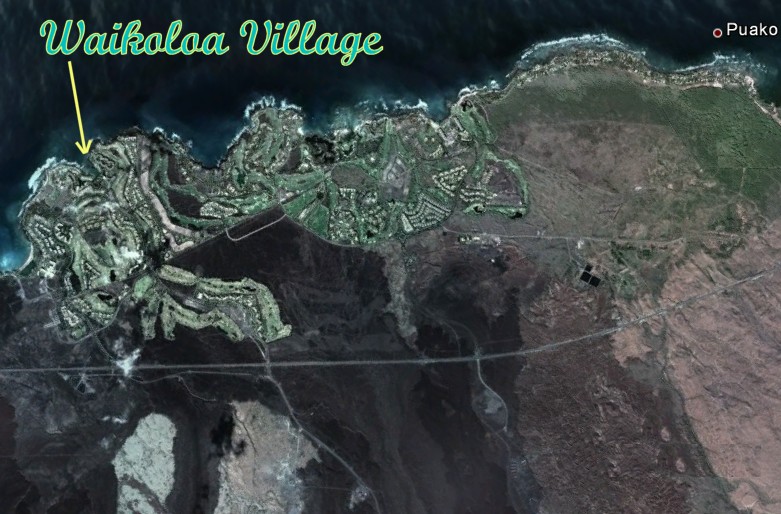 |

Waikoloa Resort
History
I found the story behind the
development of Waikoloa Village
to be interesting. A quick retelling of
the previous 200 years of Hawaiian history will help
understand
the story of Waikoloa's origin.
They say the
history of Russia is divided into "Before" Peter the Great
and "After". The same thing can be said for Hawaii.
When it comes to
the history of Hawaii, everything revolves around
King Kamehameha. This legendary strongman united the eight
Hawaiian Islands into one kingdom back in 1810.
Kamehameha's
destiny was directly influenced by the discovery of the
Hawaiian Islands by England's
James
Cook in 1779. Kamehameha actually observed
Cook's visit, but he was just a curious teenager in the
crowd at the time. (Note: As it turns
out, Cook landed just south of Kona. If you come on
our trip, you
can easily visit this location).
As it turned
out, Cook's appearance was both a curse and a blessing.
It was a curse for Hawaii and a blessing for Kamehameha.
Hawaii had remained isolated during the era of European
exploration due its unusual location. In a time when
the explorers preferred to sail along coastlines,
Hawaii's location in the exact center of the Pacific Ocean
equidistant between Asia and North America made it hard to
find.
However, once Cook revealed the existence of these lush
islands, Hawaii began to get some visitors.
This was a curse
because the Europeans inadvertently introduced viruses to
the Garden of Eden. A plague hit that killed 150,000
natives in 1804, half the population of the islands.
However, it was
a blessing to Kamehameha. Thanks to certain helpful
Europeans, Kamehameha used their modern weapons and their
knowledge of European battle tactics to gain the upper hand
in his attempts to conquer all the islands.
Kamehameha had
just finished defeating the Big Island in 1791 when he
received another stroke of fortune. In 1793, George
Vancouver arrived at the Big Island. Vancouver was
still just a sea captain at the time. The two men
struck up a friendship. In parting, Vancouver left
behind a gift that would have far-reaching consequences...
one bull and five cows.
Kamehameha
didn't know what to do with this gift, so he set the animals
free to roam around the Big Island. That had to be the
luckiest bull in world history. The cattle
multiplied at a dramatic rate.
In 1809, a man
appeared who would become very useful to Kamehameha.
John Parker, who
hailed from Massachusetts,
jumped off a ship visiting the Big Island. Parker hid on shore
till the ship left the harbor. He was 19.
It is unclear
how John Parker came to the attention of
King Kamehameha, but apparently the King took a shine to the
young man. He gave Parker several important tasks.
John traveled to China during the War of 1812, returning to
Hawaii in 1815. Upon his return, Parker brought
back a new toy. It was a state-of-the-art American musket.
How Parker managed to obtain a modern rifle in China is
unexplained, but the gun played a pivotal role in his
fortunes.
Kamehameha was
impressed with the gun's range and accuracy. He gave
Parker the privilege of being the first man
allowed to shoot some of the thousands of feral cattle that
now roamed the Big Island's remote plains and valleys. Kamehameha then
made another decision. From now on, John Parker would
be in charge of overseeing all this cattle.
Parker made a
smart move of his own. He married Kamehameha's granddaughter.
The King made a wedding gift of a small parcel of land on the Big Island.
That was the start of the Parker dynasty which would figure
in the next two centuries of Hawaiian history.
The family first
settled at a farm in the Kohala district near where
the Waikoloa Resort would eventually be developed. In
1835 he was hired by Honolulu merchant William French to
start a commercial operation selling meat products of the wild
cattle near the town of Waimea, located about 20 miles east
of Parker's farm.
When private
ownership of land became legal in 1850, Parker was in the
right place at the right time. He bought all the land
he could and switched over to ranching. Sandalwood had
been the traditional export. The Europeans loved the
fragrance of the sandalwood oil. However, the entire
tree had to be cut down to harvest the oil. Now Hawaii's
forests were rapidly disappearing.
Parker's unique
position allowed him the rare opportunity to replace
sandalwood with beef as Hawaii's new main export. The
Big Island was practically deserted. Only 2,000 people
lived there at the time. So Parker was able to acquire
vast amounts of acreage for his new business.
It was about
this time that Parker switched from hunting wild animals to
domesticating and raising them in fenced paddocks.
He brought some Mexican vaqueros over to help with the
round-up. These vaqueros trained the local Hawaiians
as well. The Hawaiians quickly became adept cowboys.
Hawaii's cowboys became known as paniolo, a
corruption of español, the language the vaquero
spoke. The term still refers to cowboys working in the
Islands and to the culture their lifestyle spawned.
At its peak,
Parker Ranch extended over 250,000 acres. It was the
single largest ranch in America at the time, but King Ranch
in Texas would soon surpass it at 825,000 acres. In
case you are curious, the world's largest ranch is the 6
million acre Anna Creek station in Australia.
Parker was a
hard-working man who was said to never take a day off.
Unfortunately, after Parker died in 1868, the quality of the
leadership dropped
a notch with each new generation. Sometimes the talent
wasn't there and sometimes the interest wasn't there.
Over time, although the ranch remained huge, it lost much of its profitability.
By the time Richard Smart, the last
owner, came along, the ranch was no longer
prosperous. It didn't help that Smart was far more
interested in dancing on Broadway than he was in
running the ranch.
Smart was
realistic. His ranch was far larger than it needed to
be. Furthermore, he had control over land such as the
lava fields that were worthless for grazing purposes.
Plus the lack of rainfall on the western side of the island was always a problem. Plagued by drought and rising costs, Smart authorized the
sale of low-yield pasture lands that would eventually become
the site of several world-class luxury resorts along the Kohala
Coast .
This began with the
sale of the Hapuna / Mauna Kea property in 1963 to
Lawrence Rockefeller. It was then followed in January
1969 by the sale of the Waikoloa property to Boise Cascade.
These were hard
decisions. Both ocean-front areas had long been the private
domain of the ranch. They were popular gathering
places for the ranch hands and their families.
Waimea, an
inland community to the north of Mauna Kea, was about 20
miles away from the Kohala Coast. Few people lived
on the Kohala Coast and the absence of any roads made this area hard to
reach. Due to its inaccessibility, members of the Parker Ranch had the
use of this
area all to themselves for 150 years.
Smart knew his
ranch hands would be broken-hearted. Picnics, camping,
swimming and boat rides made this a popular place for their
own vacations. The children and families of ranch
employees would ride horses over and hold long weekend luaus full
of laughter, food, story, song and dance.
Smart was sorry
to see the end of this era for his
community. However, he sensed that the land his
estate controlled wasn't being developed properly. It
was time to yield to march of progress.
As justification
for the sale in
1969, Richard Smart wrote:
“No longer
are the Boise Cascade developments just plans to be read
about in the newspapers and no longer is our village the
quiet and remote place we have always known and loved.
New faces,
new businesses, new advantages, and let us face it – new
problems too - are becoming more evident. Along with the
advantages of better shopping, and employment
opportunities there are the problems of more traffic,
higher prices, and lack of adequate housing.”
The next figure
in the development of this area was Ron Boeddeker.
Boeddeker headed up the real estate subsidiary of Boise
Cascade, a timber-products giant, here on the Big Island.
After the
acquisition of the lava field in the late 1960s, Boise
Cascade envisioned a massive project from the start.
Planning began in the early 1970s to convert more than
30,000 acres of volcanic ash into a resort with golf courses
and outlying communities of upscale homes. A great
deal of thought and imagination was invested into the
project.
However,
something must have gone wrong. Unfortunately, I was
unable to determine what the problem was. All I know
is that in the mid Seventies, Boise Cascade decided to sell
off its oceanside property.
Apparently
Boeddeker was assigned the task of liquidating the Boise
Cascade's real estate portfolio after it decided to get out
of the real estate business in Hawaii.
After selling most of the properties, Boeddeker formed his
own company, Transcontinental, to buy the remaining assets.
Transcontinental’s Hawaii property
was located on an arid part of the island
with a terrain of
hard, black lava.
After crushing lava and installing
drip irrigation,
Boeddeker's
Transcontinental Corporation
began the metamorphosis. 4,000 acres
of lava wasteland slowly became Waikoloa Village.
The wasteland was transformed into a terrain of
lush seaside golf courses and rainless rain forests.
Next came two golf courses, two
hotels, more than 400 condominium units and a shopping
center.
At some point
during the Waikoloa development, a flamboyant entrepreneur
named Chris Hemmeter entered the picture. Somehow Hemmeter ended up taking all the credit for creating
Waikoloa Village.
For example, here is
a brief clip of what the
Hilton Waikoloa website says about Hemmeter:
Chris Hemmeter was a prolific developer of mega resorts
and always preferred to start with a gigantic slate -
which meant a lot of digging and grading through lava.
I might add the
website has nary a word about Boeddeker.
Considering
several websites gave Boeddeker the credit for overseeing
this project all the way back to Boise Cascade's initial
purchase, I thought it was
odd that Hemmeter's name managed to become the one most frequently linked
to the success of Waikoloa.
So I Googled "Chris
Hemmeter" and "Ron Boeddeker" and "Waikoloa" together.
Unfortunately, I
was unable to find any account that explained the
relationship between the two men. Of course, there was
no Internet in those days, so it is not that surprising that
the details are limited.
All I can tell
is that Hemmeter became an investor in
Boeddeker's massive project... and ended up with most of the
credit. How he pulled that off... and how Boeddeker
felt about it... I will never know.
Boeddeker's obituary
makes it very clear that he was directly involved in the
project. For starters, this picture shows him present
at the Grand Opening.
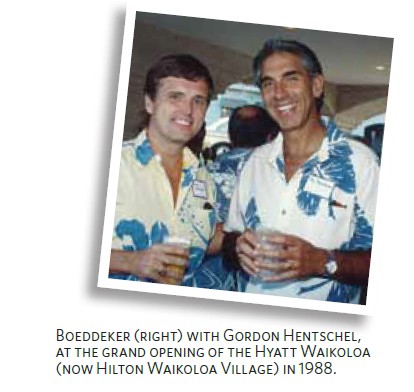 |
Ron
Boeddeker's Obituary
The name Ron
Boeddeker may not be as well known to resort guests as
Bill Marriott, Conrad Hilton, or other titans of the
leisure industry. But that is exactly how Ronald
F. Boeddeker would have wanted it.
Boeddeker did not
seek the spotlight, spoke to the media infrequently, and
preferred to remain low-key and behind the scenes.
Without Boeddeker's vision, though, Waikoloa Resort may
never have happened.
"My dad had
a special gift," says Cary Krukowski, Boeddeker's
daughter, who spent many months as a youngster living
with her family on the Big Island while the resort was
being developed.
"Dad was the kind of visionary that
doesn't come along very often. He had no fear of
failure, no boundaries to his vision. He was always
looking to create something extraordinary."
Boeddeker
first laid eyes on what today is Waikoloa Resort
in 1972. At the time, the land from makai to mauka
(beach to inland) was not much more than vast lava
fields as far as the eye could see.
But Boeddeker saw something more.
"He took my mom to
look at the property," Krukowski tells. 'Look at this
land,' he said to her. 'Can't you see golf courses and
hotels?'
My mom
looked around and said, 'Are you crazy?' All Mom could
see was a desert of black lava and a beautiful ocean."
Not one to
be easily dissuaded, Boeddeker persisted. Eventually he
found others who saw the same potential in the land that
he did, and were willing to invest. Early investors to
the project included the Texas-based financiers the Bass
brothers, hotel developer Chris Hemmeter, and
Johnny Bellinger, the longtime powerful head of First
Hawaiian Bank.
Krukowski
added, "Dad would run into all kinds of people who would
say 'No!' But Dad had a way of making people
believe in his vision."
"“My dad was
very fond of the Hawaiian culture, and of the people of
Hawaii,” Krukowski says.
“He embraced
everything Hawaiian. He greatly respected the deep
traditions of the islands, and loved the fact that the
culture is so family oriented. He was very family
oriented himself, and that gave him a strong bond with
the people of Hawaii.”
Boeddeker
passed away in 2010 at 71 years of age. His family
installed a plaque to his memory that guests pass on
their way to the beach from the Waikoloa Beach Marriott.
Krukowski says that is exactly where her dad would want
to be.
“Waikoloa is a beloved place to our family,” she says.
“This is where my dad really started to dream big, and
it is so gratifying to see this special place he
envisioned more than 40 years ago become a world-class
resort enjoyed by so many.”
This obituary is practically the only place on the Internet
that explains
Boeddeker's
contributions. Otherwise his relationship to Waikoloa
is practically invisible.
I think we can infer that Boeddeker needed Hemmeter's money
and political influence to get his project properly funded.
Then perhaps we can assume that once the resort was built,
the media-savvy Hemmeter managed to take
most of the credit for himself. The one who does the
majority of the talking has an advantage here.
As it stands,
today Chris Hemmeter, a longtime friend of President Jimmy
Carter, is the only person given any credit for the project
on the Hilton Waikoloa Village website.
Here is what the
Hilton Waikoloa website says about Chris Hemmeter:
Hilton
Waikoloa Village was originally drafted on a simple
cocktail napkin.
Chris Hemmeter was a prolific developer of mega resorts
and always preferred to start with a gigantic slate -
which meant a lot of digging and grading through lava.
Hilton
Waikoloa Village is the amazing result of his endless
imagination. Construction began in 1986 and
the resort was completed in 2 years time in 1988 with a
budget of $360 million.
Hemmeter's vision evolved into a tropical paradise
complete with three towers with 1240 rooms, trams, canal
boats, a saltwater lagoon, three pools, eight
restaurants, a seaside putting course and $7million in
artwork.
Hemmeter had a knack for seeing possibility where others
did not. He once said, “You have to serve customers the
wine they want, not the wine you think they should
have…”
Hemmeter spent a week in one of our elite suites,
suitably named the "Hemmeter Suite" just before he
passed away in 2003.
The resort actually opened as a Hyatt resort and later
sold in 1993 to a Chinese company, Global Resort
Partners, and Hilton Corporation.
In 2002, Hilton Hotels Corporation purchased Global
Resort Partners' shares, making Hilton Waikoloa Village
100% Hilton owned.
With the strong resources of Hilton Hotels Corporation,
we have worked hard to ensure Hilton Waikoloa Village is
the resort of choice for our guests and visitors. Our
tropical paradise continues to evolve as we renew,
refresh and establish ourselves as a true resort
destination.
With a capital investment of over $101 million in
projects since 2005, we strive to distinguish ourselves
through our continuous improvement efforts. We have
completed numerous improvements and additions to the
resort's offerings, increasing levels of comfort while
instilling the unique Hawaiian culture into hotel décor
and services.
As you can see,
Boeddeker's name is not even mentioned. Very odd.
|
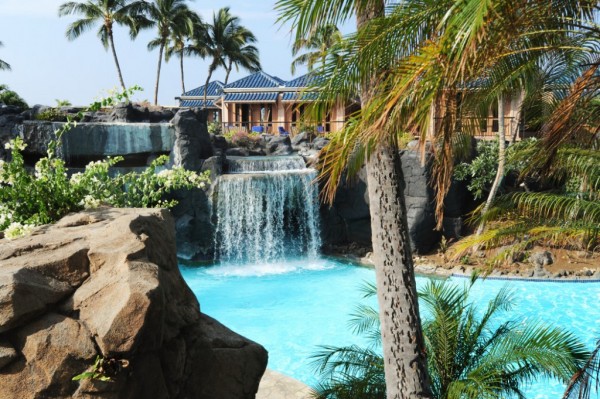
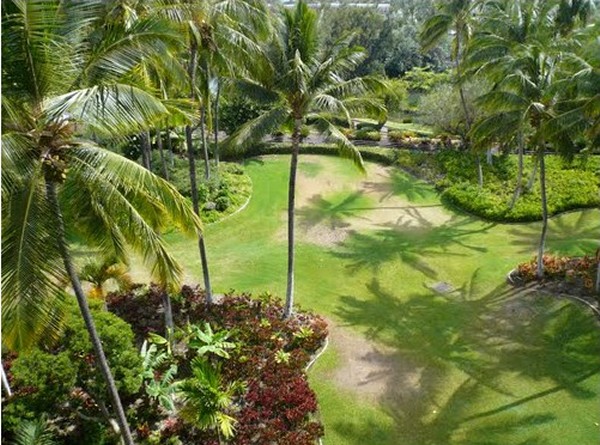
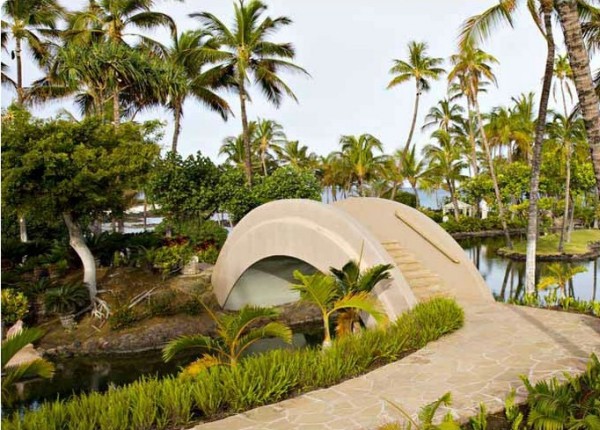
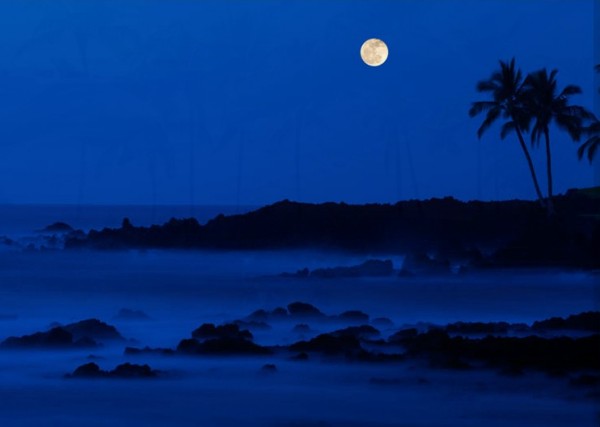
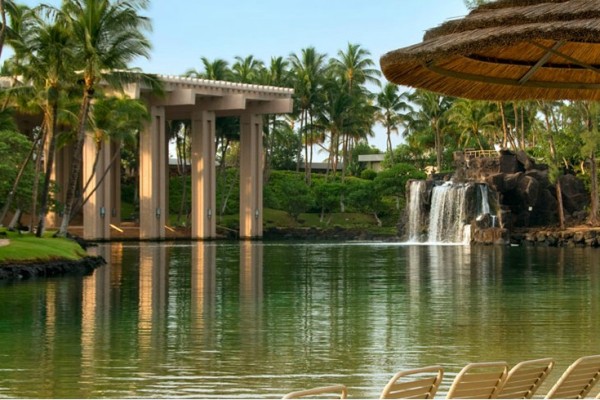
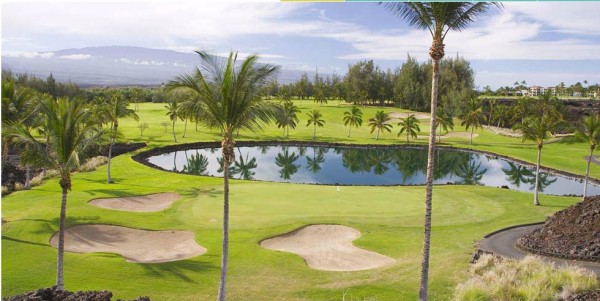
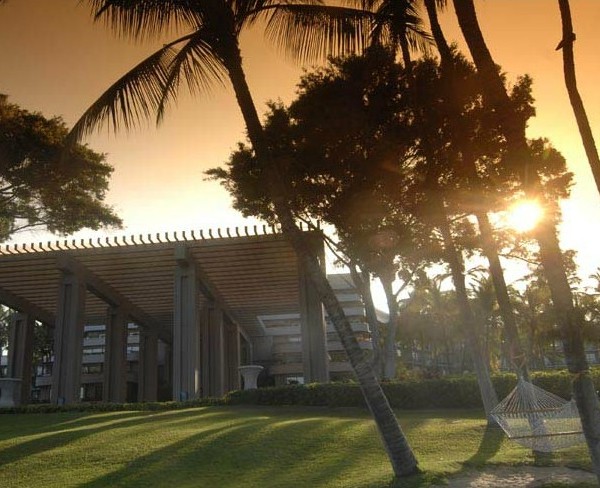
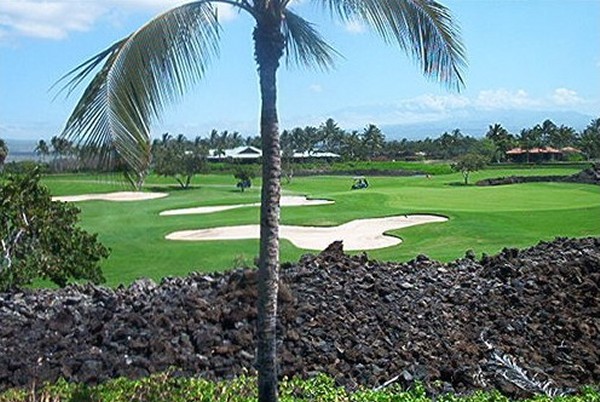
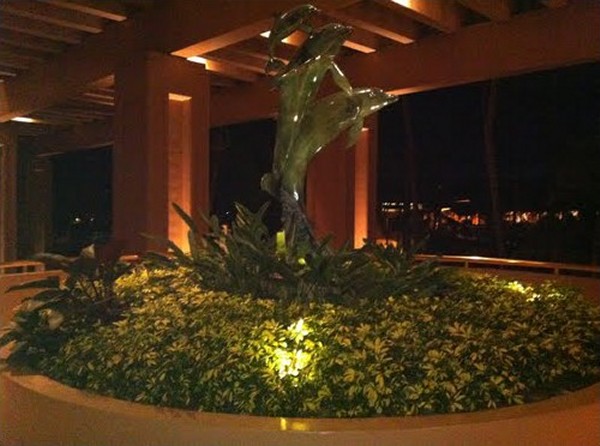
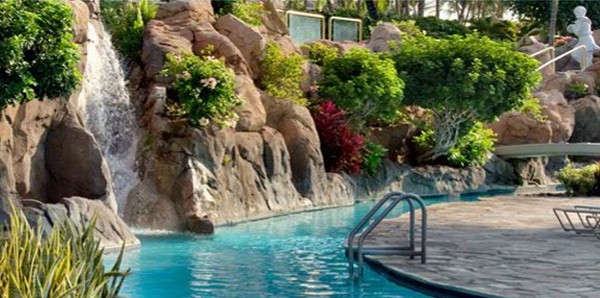
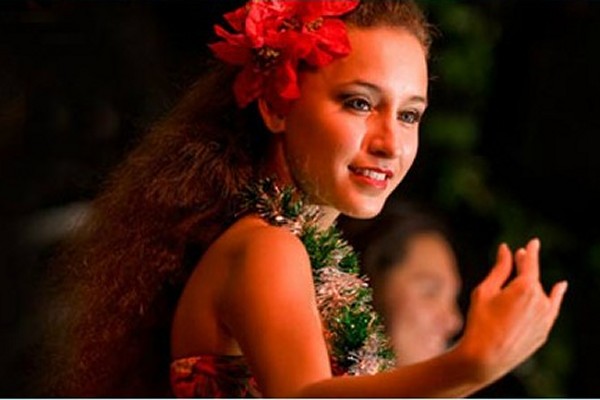
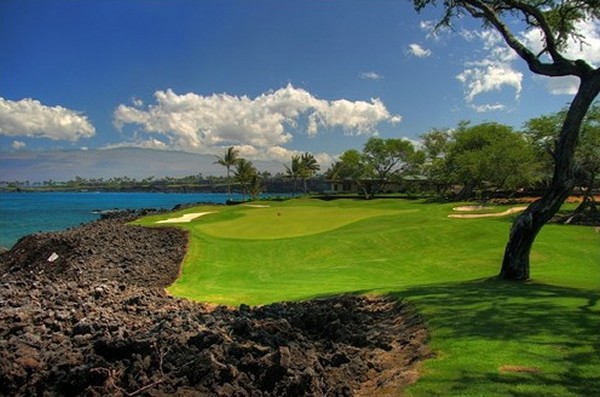
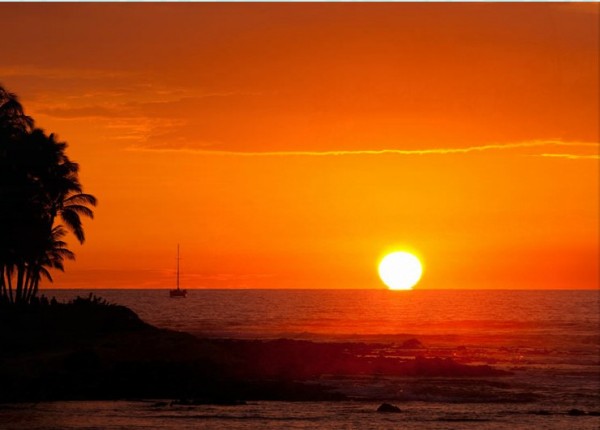
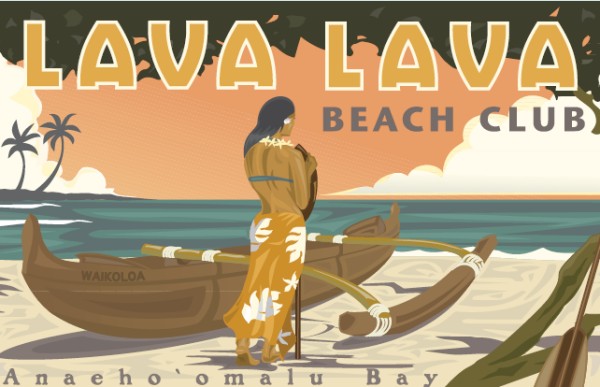
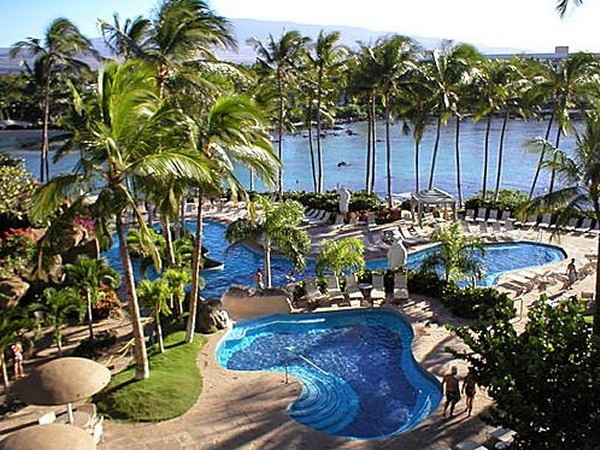 |
The
High Stakes Game of Resort Development
Ironically,
despite their amazing success at Waikoloa and
later projects as well, both Hemmeter and Boeddeker would suffer
humiliating defeats late in their careers. Here are the
two
stories.
|
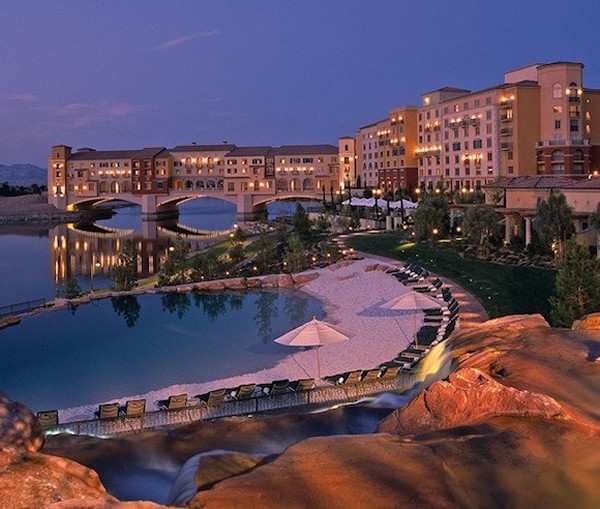 |
Boeddeker's Dreams Die in the Desert
Ron
Boeddeker's original vision was
to re-create a Lake Como-like, Mediterranean enclave 17
miles from the Las Vegas strip.
In the grand
pantheon of great visions, this was one of the most
expansive. Multi-million dollar residences would be built
along the lake, there would be fine hotels, excellent food,
substantial golf courses. It was a vision that had legs.
Thanks to Mr. Boeddeker's unusual expertise -- his
University training in civil
engineering and his previous experience
in Hawaii -- he almost
pulled it off.
Boeddeker was one of the few developers who could envision a 320
acre lake in the middle of a desert and
also know how to create it from a practical
engineering standpoint.
The dark side of such a vision was
its dependence on a
recession-resistant economy over a fairly
lengthy period of time.
But the economy was not recession-resistant.
The Las Vegas real estate market soon
deflated and the community's three golf courses went
into foreclosure. Even with celebrities buying
houses and the exceptional hotels
and golf courses in active use, Lake Las Vegas
was deeply affected by the
downturn in the economy.
Boeddeker's
Transcontinental defaulted on $540 million in loans
in the fall of
2007 and went into foreclosure.
|
| |
|
Hemmeter's Waterloo
In 1991,
Chris Hemmeter began to develop
casino gaming projects. His biggest project was a proposed
$1 billion casino in New Orleans. It was
billed at the time as "the world's largest casino".
The developers estimated the casino
would attract one million additional visitors to the city
and would generate annual revenues of as much as $780
million, estimates that were based in part on the proven
success of dockside gaming in the Mississippi Gulf Coast
area.
In 1993 a partnership of Hemmeter
and Caesars World obtained the lease on the Rivergate
property, which by law was the only place the land-based
casino could be built in Louisiana.
They beat out a rival bid
by Harrah's. However,
in August,
1993, the State Casino Board awarded the state's sole casino
license to Harrah's and not to
Hemmeter.
The impasse of one company owning the only license and
the other owning the only lease was resolved when the two
entities formed a joint venture under pressure from
then-Governor, Edwin Edwards.
|
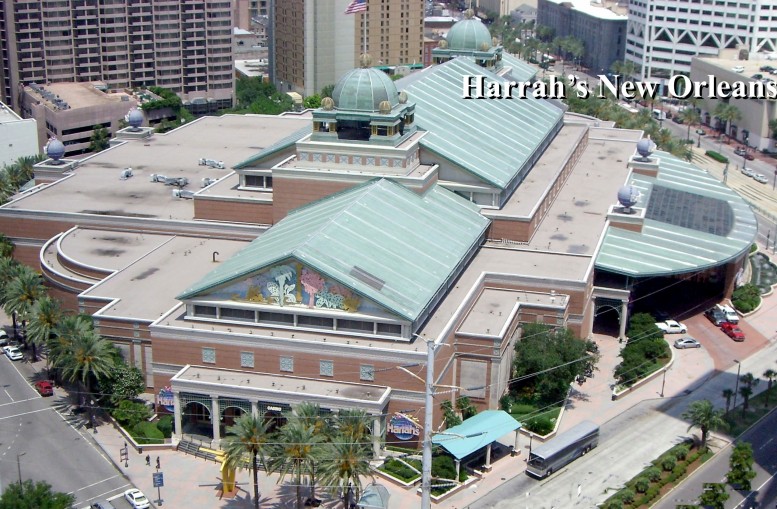 |
Titled
"Harrah's Jazz", the new partnership
established a temporary casino in the Municipal Auditorium
in order to establish a cash flow while the main facility
was under construction at the Rivergate. The
temporary facility opened in May, 1995, and a week later was
closed due to a flood.
The
poor location of the site resulted in the actual gaming take
falling 60% below projections at only $13.1 million per
month.
Harrah's Jazz halted construction on the permanent facility
at 3 am the day before Thanksgiving, 1995, and laid off 1,600
construction workers, 2,500 casino employees, and filed for
bankruptcy. Later, the project was taken over by Harrah's
who built the Harrah's New Orleans Casino on the site of Hemmeter's project.
Hemmeter filed personal bankruptcy in 1997.
His attempt to enter the casino business in New
Orleans became what one associate called his Waterloo.
Hemmeter told The
Times that he had plummeted "from a net worth of $750
million down to zero in a matter of months." Court documents
showed that he had about $720,000 in assets and $87 million
in liabilities. Hemmeter spent his
final days explaining how the dirty politics in Louisiana
had done him in.
Ironically,
Harrah's went on to make the venture very successful under
its own brand.
|
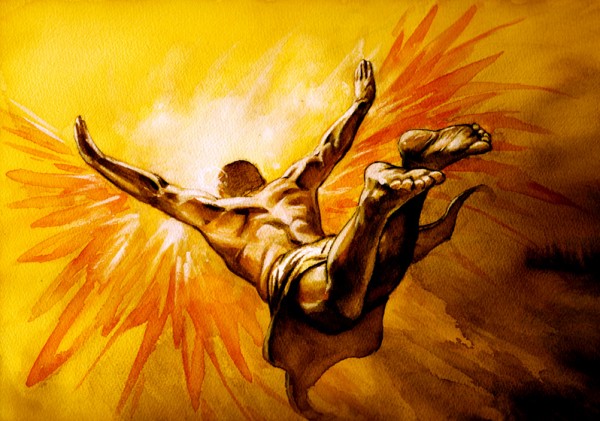 |
The Icarus
Effect
So you might be curious
why I wrote about the economic miseries of the two Waikoloa
founders.
I am fascinated by people who develop huge
projects. The risks involved are so great that I cannot
imagine having the guts to roll the dice like these people do.
It seems like developers must have some type of confidence which
tells them they can't fail. Invariably 'confidence' turns into
'conceit' and one day these guys seem to bite off more than they
can chew.
I call it The Icarus Effect.
Take Bugsy Siegel for
example. Bugsy was the first guy to see the potential in Las
Vegas. However, he didn't get the results fast enough to
satisfy the impatience of his mob buddies who bankrolled the project.
They shot him.
Historically, the
greatest failures are often preceded by amazing success. In 1854
Ferdinand de Lesseps of France received permission to build the Suez
Canal. His project was so successful that investors from
around the world lined up to back his next project, the
Panama
Canal.
|
De Lessups got nowhere.
After 10 years of futility, losses of $20 million dollars plus the
yellow fever deaths of
20,000 men, France totally gave up. France sold the rights
to the canal to the United States. De Lessups'
disastrous Panama Canal
effort was
perhaps the greatest engineering flop in the history of man.
|
I read that
Atlantis in the Bahamas was a miserable failure when it
first opened. Merv Griffin and Donald Trump both tried to make
a go of the place only to give up in disgust. For that
matter, the Waikoloa project did not succeed the first time around.
The Hyatt was forced to sell it to the Hilton.
It takes a lot of guts
to invest in a project like Waikoloa. These places don't
always succeed. And even when they do succeed, it ain't always
the early bird that gets the worm, but rather the second mouse that
gets the cheese... if you know what I mean. There are unseen
pitfalls everywhere.
|
 |
|
Waikoloa Village
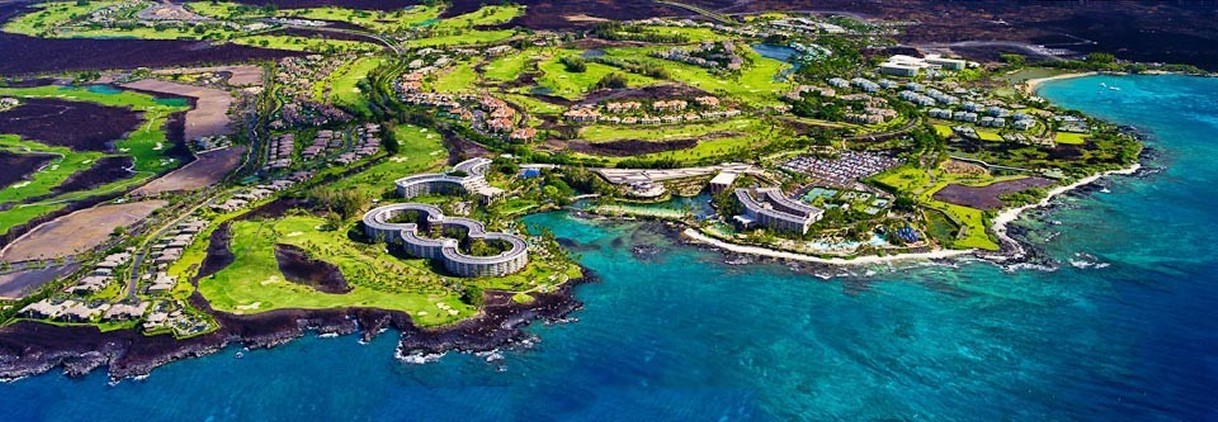 |
Building
Atop a Lava Field
Of all the
things I read about Waikoloa, the one thing I find the most
fascinating is how they built the resort on top of a lava field.
The picture above clearly shows the underlying rock foundation. Rising from an endless sea of black lava, Waikoloa
is a perfect example of man working in harmony with nature.
If you study the golf
course pictures, wherever you look, it is obvious that the greens
are basically carpets laid on top of lava. Notice how the
course designers used lava to line each
golf hole. When you hit a golf shot in the
rough, like as not it gets stuck in the lava field. Try
chipping out of that!
The designers
transformed this stark moonscape into a tropical garden by spreading
thousands of truckloads of topsoil over the lava. They
sprinkled it with tons of grass seed. Next they transplanted
more than 1,600 palm trees at $1,000 apiece. Now they had to
solve the problem of the arid climate. As a final touch, they
built a giant irrigation system to nurture this former wasteland
into a stunning oasis. The pictures are testimony to their
success. When man decides to assist nature, the results can be
stunning.
|
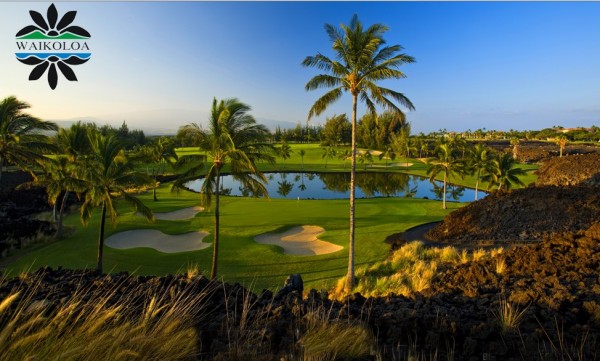 |
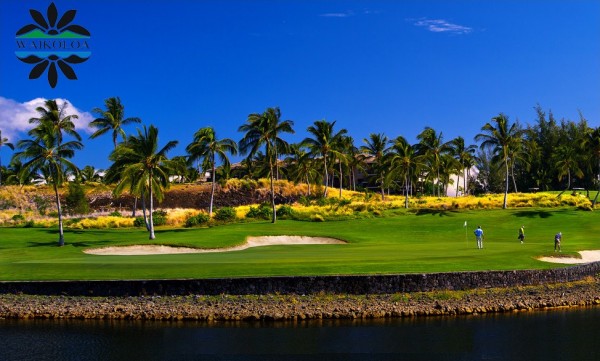 |
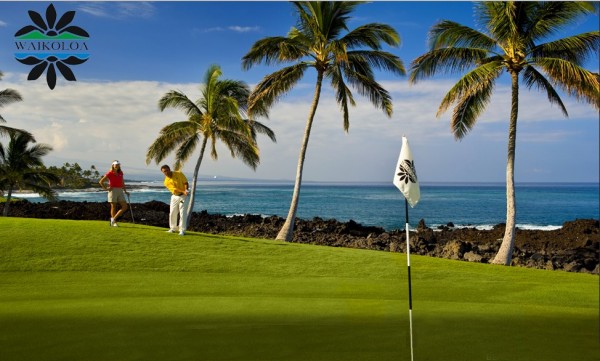 |
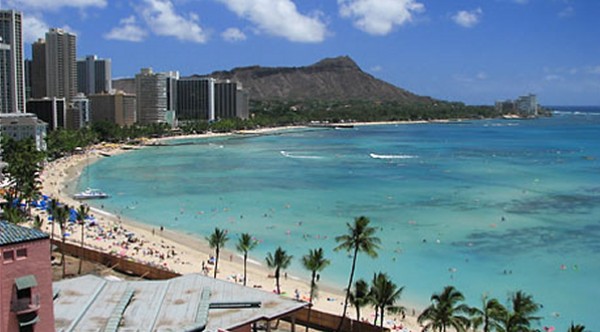
Waikiki Beach, Oahu |
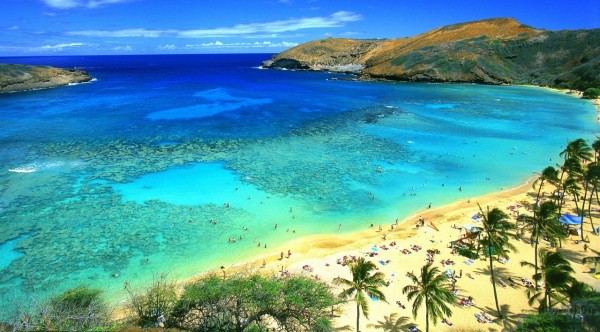
Hanauma Bay, Oahu
|
The Great
Mystery of Waikoloa
Everybody knows that
Hawaii is home to some of the most stunning beaches imaginable.
In fact, Waikiki Beach in Honolulu is one of the most famous beaches
in the world. Nearby Hanauma Bay is a close second.
Something that always
startles the guests at Waikoloa is the discovery that this fabulous
resort has one of the ugliest beaches they have ever seen.
That just blows their
mind. How does a multi-million dollar resort in Hawaii, home to
some of best beaches in the world, end up without a decent beach?
When I was poring over
the literature for Waikoloa, it seemed strange to me that they never
said a word about their beach. Considering they hyped
everything under the sun, why was there no mention of the beach?
Curious, I visited
Google Earth. (Note: If you don't have this application
on your computer, go to the Internet and get it. It's free and
it's fun.)
As I zoomed in on the
Waikoloa Village, it sure looked like they had a beach. Check
out the picture with the pink arrows. What do you think?
Doesn't that look like a white sand beach to you?
One of the features of
Google Earth are the ubiquitous Panoramio photos. Anyone is
welcome to upload pictures of the various places they visit.
Curious, I clicked 20
different icons near the Waikoloa beach for clues. Nada.
All I got were sunset
pictures, pictures of the ocean, and pictures of the resort.
Where is the damn beach?
Where are the palm trees, the lounge chairs, the swimmers and the
beach towels? Not one single picture. Nothing.
Then I clicked on the
photograph you see to the right. White rocks. Hmm.
If you had lots of white
rocks and you were taking a picture from outer space, would white
rocks show up looking like white sand? You betcha!!
I laughed out loud.
I had just discovered a secret. Waikoloa doesn't have a beach.
And they don't want you to know that!
I think I can understand
their frustration.
How would you feel if 29
out of 30 beaches in Hawaii were stunningly beautiful and you just
spent millions of dollars buying the ugly one?
You're the publicity
agent. What are you going to say?
"Come to Waikoloa
and see the most sensational sunsets, the finest
golf courses, and the ugliest beach in the state!"
Nah, probably not.
That's not what you are going to write. More likely, you won't
even mention the word 'beach'. Well, to their credit, they did
say they had a 'beach', but they left it at that. Caveat
emptor.
As it turns, yes, the various
Hawaii
islands do have many sensational beaches, but at this particular
spot on the Big Island, Mauna Kea's ancient lava flow
made certain to ruin everyone's fun.
It's one thing to bring in tons of dirt to make a golf course.
After all, dirt is cheap! But apparently they didn't bother to cover those nasty rocks with
beautiful sand. For one thing, it might be dangerous to try.
It crossed my mind that
as the sand gets washed out to sea in the high tide or in a storm, someone walking barefoot could easily cut their
foot on sharp lava rock barely hidden by the remaining sand.
But if everything is rocky, then people have the sense to wear shoes
or sandals.
I noticed in a
travelogue there might be one section of sandy beach.
Because Waikoloa was carved out of a wasteland of lava that flows to
the ocean itself, it was necessary to create a beach. The truth be
told, it's not much of a beach. Furthermore, it was necessary to
haul in each little grain of sand.
One can windsurf, but it
is a
disappointingly short ride.
I was unable to find a
picture of the alleged sandy part of the beach. However I did
find a picture that shows Waikoloa definitely has a beach.
However, if you take a second look, you will notice something is missing.
What could it be?
There are no people.
What does that tell you? It says the beach is so
uncomfortable, no one wants to use it. In fact, it is so
uncomfortable, no one wants to walk on it either. Obviously that is the
white rock beach.
Oh, so what. If you are a
developer, why let owning a lousy beach stop you?
If you can overcome a
vast range of black lava rock, then there has to be a solution for a
rocky beach. Why not build your own
series of water venues and add a protected beach? For
starters, at least you have a perfect supply of good clean ocean
water. I think
that's exactly what they decided to do.
In this case,
compensating for their lousy beach helps
to explain why
Waikoloa developed such an incredible collection of stunning water vistas.
The four acre
system of pools at Waikoloa Village are
something to behold. A guest can whisk down a
175-foot-long twisting water slide, admire
Hawaii's colorful fish or relax with a book in a swinging hammock.
There
are boats and floats everywhere for people to take out in the water.
It is the best of all
worlds. Sun worshippers can bask out in the open and people
who hate the sun can hide under palm trees. No one ever
breaks a sweat in the balmy climate.
Even better, in addition to the gentle
ocean breezes and the perfect 72° temperature, there are no bugs!
The resort boasts three freshwater swimming pools and a
saltwater lagoon, each unique in its own right. One million gallons
of water fill the trio of pools, with an additional 5,000 gallons of
saltwater pumped each minute to circulate through the Saltwater
Lagoon and canal system. The water is
sparkling.
Largest of the three, the Kona Pool features a dramatic waterfall
that cascades into the pool from overhead.
Swimmers can duck underneath,
giving them a feeling of being inside a
water-cloaked cavern. Three Jacuzzis
are set within rocks and caves, a swinging bridge
crosses the oversized pool and a sandy-bottomed children's section
makes this place safe for kids.
At Waikoloa, I noticed a
lovely area titled "Lagoon
Beach". I have included a picture of it.
Here you can see a small beach overlooking the
Lagoon. This is another example of the lengths the developers
went to overcome the beach problem. They succeeded well.
The pictures
make it clear that just like
Atlantis in the Bahamas, the developers turned Waikoloa into
an amazing
water paradise.
In fact, Waikoloa may
have even served as the inspiration for Atlantis.
So there you have it.
Thanks to the lava problem, Waikoloa became a resort with man-made
grass, man-made jungles, man-made canals,
man-made lagoons and man-made waterfalls
cascading over man-made cliffs.
In the greatest irony of
all, the man-made cliffs are made out of man-made lava.
Personally, I don't care
if these vistas are artificial or not. I can't imagine many
spots on earth much prettier than this Lagoon Beach
shown here.
|
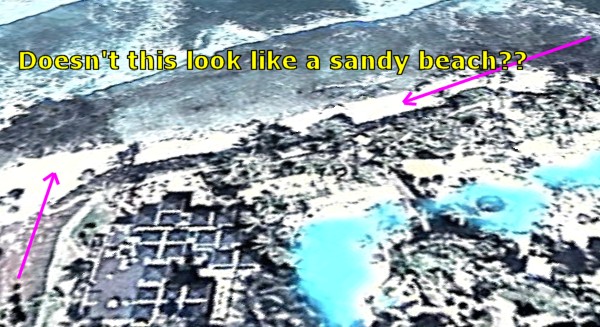
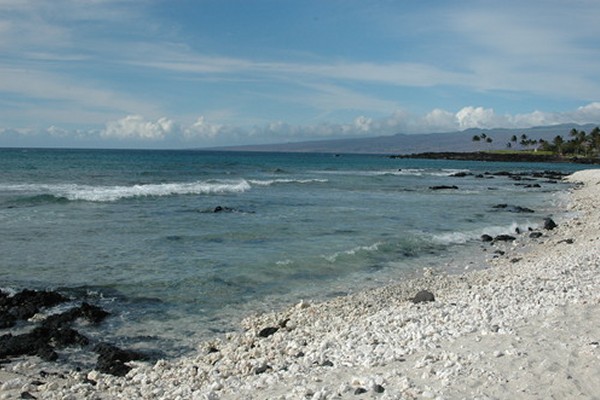
The White Rock
Beach
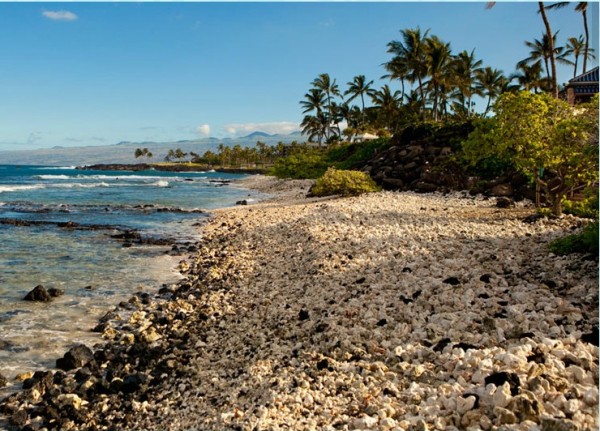
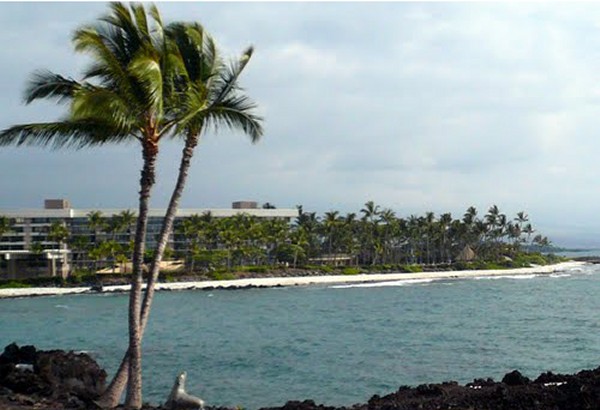
Another Look at
the White Rock Beach
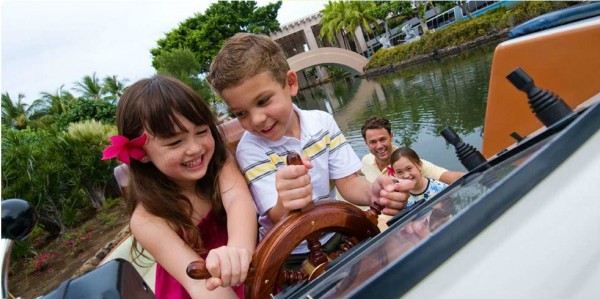

Lagoon Beach
|
|
 |
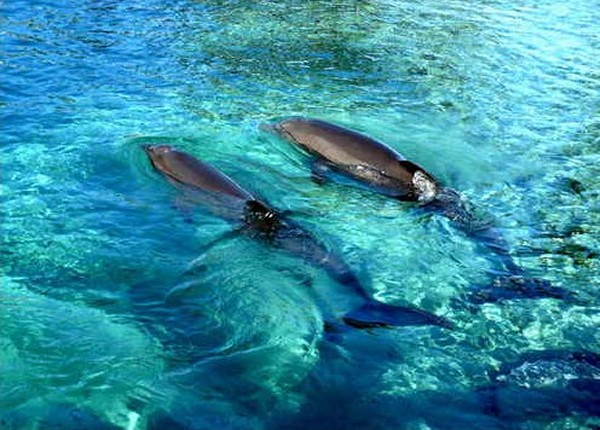
Dolphins |
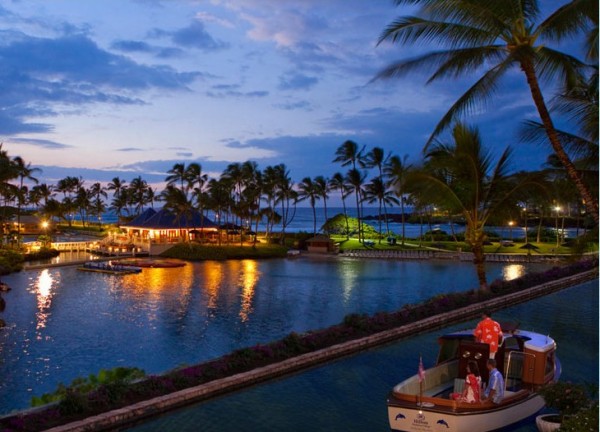
Canal on
one side, Lagoon on the other, Ocean in the background
|
|
If you study the map,
you will see a series of wavy lines in the water. This is actually a
canal. You can take a shuttle boat from one end of the complex to the
other.
Using the ruler function
of Google Earth, I estimate the length of the canal at close to a
mile. Whether you can also swim the canal I do not know, but
I doubt anyone wants to.
In addition to the Grand
Canal, you have lagoons and swimming pools in every corner of the
complex. If you look, they even have a "Lagoon Beach" with
sand.
One of the lagoons features
dolphins. A favorite attraction is a swim with the
dolphins.
Unfortunately, since Waikoloa possesses only six dolphins
compared to dozens of requests, they conduct
a daily dolphin lottery.
Thus only a handful of guests win the
chance to swim with the dolphins.
Nevertheless, it is a
charming spectacle for everyone to watch the lucky
guests as they interact with these friendly creatures out in the
water.
|
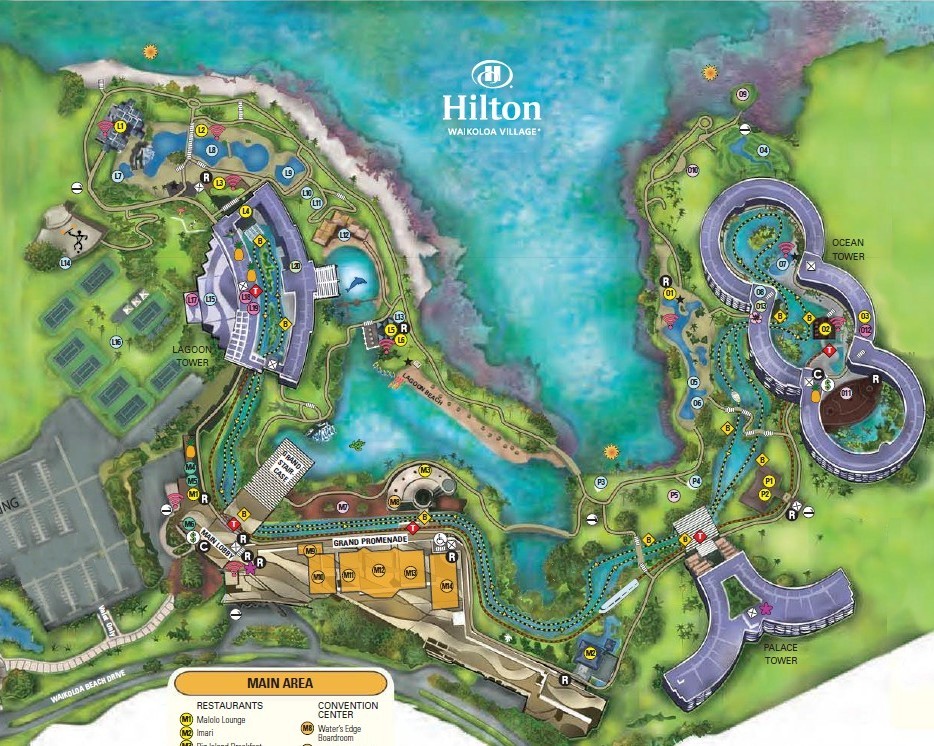 |
The complex is
divided into three towers: Lagoon Tower, Palace Tower, and
Ocean Tower. These towers are where the guests stay
in the
1,240 rooms
There is a giant
inlet that adds to the attractiveness of the resort.
Rather than line up all the different areas in a square or a
rectangle, the designers were able to wrap the structures
into a U-Shaped complex (see map above).
This means the people in the different areas can see the other
hotel towers.
The complex stretches nearly a mile from end to end.
So in addition to the canal,
they installed a monorail to help
people get to their spot
among the . If you look
at the map above, you will see the rail runs parallel to the canal.
The Main
Lobby and Grand Promenade is a fourth area that serves as
the central location. Here the guests can check in, as
well as find restaurants, meeting
places, convention halls, and shopping areas.
In addition to
the rail shuttle and the boat shuttle, there are plenty of
trails connecting the facilities for an old-fashioned mode
of transportation known as "walking". Imagine that.
There are
several bridges throughout the complex that connect the walking
trails to the four different sectors of Waikoloa.
|
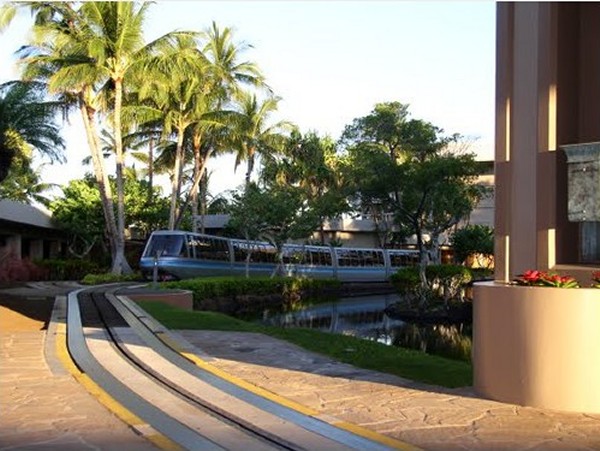 |
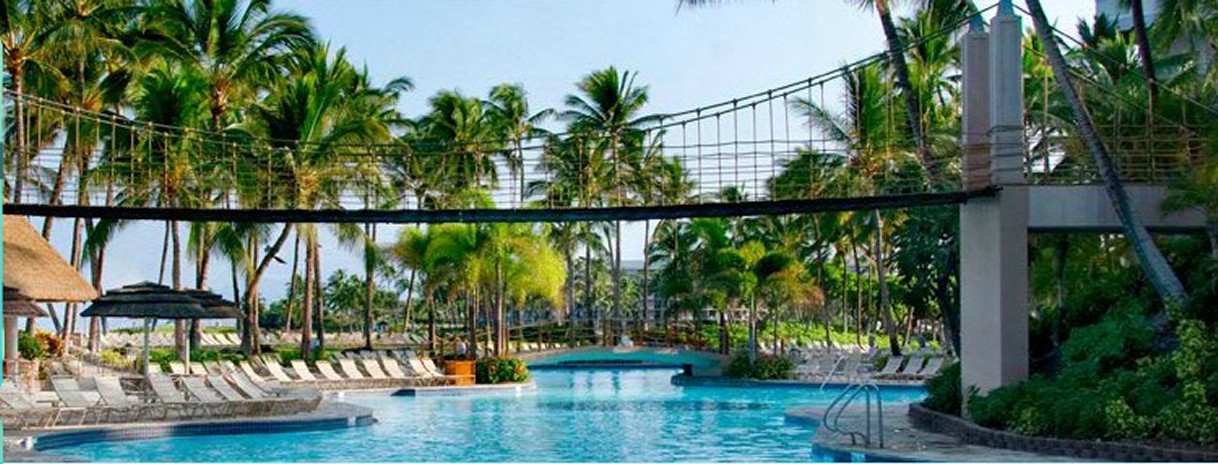 |
 |
Protecting the Environment
One of the original
predictions of Waikoloa developer Chris Hemmeter
was that the entire Kohala Coast would be
someday be lined with hotels, homes and condominiums
-- from Mauna Kea nearly to
Kailua-Kona -- in much
the same way the Jersey seaboard has become an endless series of
interlocking boardwalks.
Now that the thirty
years report card has come in, it looks like Hemmeter's prediction
was on target. Although there is quite a bit of land still
open for development, the irresistible lure of a home on the ocean
has led to a series of well-heeled communities that dot the
coastline.
Google Earth makes it
easy to spot them. Black lava fields are interrupted by a
green oasis, then more black lava fields, then another green oasis.
As America's baby
boomers look for second homes or a place to retire, the coastline
landscape of the Big Island is changing rapidy.
Those who knew and loved
the old Hawaii may find places like Waikoloa beyond
comprehension. Gigantic and expensive, it is representative of other
mega-resorts that stand in stark contrast with the old, unspoiled Hawaii.
When you realize that
Waikoloa transformed a wasteland into a paradise, maybe this change
isn't such a bad thing.
As
the fragile beauty of this unique island nation disintegrates,
perhaps the resorts can be looked to preserve the original beauty of
the tropical forest in much the same way that a game preserves
protects its animals.
More and more, humans
are learning not only to protect the environment, but to make
improvements where possible.
Indulgences
I haven't mentioned that
for the rich, I ran across an article that suggested various
delights that exceed the pocketbook of ordinary people like me.
At the of the list of Waikoloa fantasies
is a private picnic for two at 3,000-foot Lauhala
Point, a secluded spot that's reached by helicopter. The two-hour
jaunt, which includes a flight over ranches and volcanoes, comes to
a whopping $1,325 per couple. An extra hour runs the tab up another
$760. Let me add these prices should be
adjusted up inflation.
Other couples can embark on sunset dinner cruises, complete with
a valet. Back at the dock, the couple is whisked away by chauffeured
limousine back to the womb at Waikoloa. The five-hour package
figures out to $1,470 per twosome.
There are a myriad other choices. Take the five-course meal at
historic Hulihee Palace, the former retreat of Hawaii's kings and
queens in the village of Kailua-Kona. This dinner features the
favorite dishes of King Kalakaua and a check for $2,745--the price
for four guests.
The same foursome can join an eight-hour tour of the 2,200-acre
Kahua Ranch, helping round up cattle with the paniolos (Hawaiian
cowboys) for a mere $2,150, which figures out to a few bucks under
$270 per hour.
Still, not all fantasies pay off in favor of Waikoloa. A while back,
a group of yuppies guzzled $2,600 worth of Dom Perignon at a
luncheon that was pre-billed at $450. The hotel took a bath; the
yuppies walked off with hangovers.
One idea that never got off the ground, much to the relief of
vacationers searching for solitude, involved formula car-racing
lessons. Imagine coming to this laid-back island and gearing up like
Mario Andretti. On the other hand, you
never know, maybe this idea will come back into fashion. It isn't
like those lava fields have any other pressing practical value.
On Hawaii's famous Parker Ranch, Waikoloa's guests
can hunt wild boar,
wild turkey, goats and sheep that wind up on the dinner table back
at the hotel. The price for playing Jungle Jim is $825 for the first
hunter and $395 apiece for others joining the safari.
Not all fantasies are so expensive. A six-hour bird-watching safari
is bid at $226, and there are horseback rides ($40), tours of Parker
Ranch ($30.80), a trip by ocean submarine ($67), visits to the
volcanoes ($45) and star-gazing cruises by sailboat ($55). Waikoloa
lists other choices, including golf at two major courses ($60 and
$75 for 18 holes).
Decorations
Waikoloa bills itself as "the most spectacular resort on earth." A
brochure gushes: "The senses are indulged, passions are requited and
the pursuit of happiness is limited only by your imagination."
Before his passing, James Michener,
the author of Hawaii, got carried away as well. "Waikoloa
is the kind of place God would have built if he had
sufficient cash flow."
There is so much to describe. For example,
the centerpiece of the resort is
a $2 million
dollar Grand Staircase (pictured) which
descends to a saltwater
lagoon teeming with tropical fish.
Then there are the statues. Waikoloa displays
these works of art throughout the complex. Peering from
the foliage are Buddhas, nymphs and an assortment of other
creatures. It gets downright spooky at times. Especially at night
when one comes eyeball to eyeball with a marble dragon.
The statues are just
part of the $7 million dollars Chris Hemmeter spent to decorate his
prize. Guests who decide to skip the gondola or the train can
stroll down
the a mile-long Museum Walk with $3.5 million worth of Pacific
and Asian art.
Of course, as always,
beauty is in the eye of the beholder. One curator labeled
the collection "pure junk"
while a guest
praised the holdings as "inspirational."
The path is strewn with tribal masks, ceremonial masks, drums,
spears, Thai carvings and paintings, along with dozens of other
artifacts gathered from Bangkok to Bali. A fountain from Italy
gurgles in one courtyard. And there's
a "Chinese" vase that was
cast in Encino, Mexico.
Still, Hawaii creates its own magic. Look one
direction and see Mauna Kea stare back at you. Or look across
the water and see the island of Maui just 50 miles away to the
north. Obviously Maui was on the Hot Spot just prior to the
Big Island's debut as the new kid on the block.
Trade winds continue to funnel
up volcano slopes, and the sky smolders at sundown.
As the skies darken, guests board the train to
pick up a mai tai at the "End of the Line Bar",
then cross a
swinging bridge with camera in hand to capture
one of Hawaii's memorable
sunsets on the terrace.
There are joys scattered throughout the grounds.
In one spot one can view the royal fish ponds.
In another spot, there is a water hole filled with bright orange koi
fish.
For the archeology
buffs, there are petroglyphs
preserved on the estate
that date centuries before the first tourist waded ashore.
In every direction,
there is dense tropical foliage, stately palm trees and thick grass.
There is so much natural beauty that it is
hard to imagine that just
thirty years ago this entire area was covered in a lava flow.
Considering how much
money and "love" was put into the building
of this resort, it is hard to believe Waikoloa stumbled badly
getting out of the gate.
Perhaps there was a
Hawaiian curse. There are all kinds of curses on these
islands. This place is filled with more superstition than a
dark alley in the New Orleans voodoo section.
One curse says never to
take anything that belongs to Hawaii home with you. I know a
friend who took a Maui rock home as a souvenir, then fretted for
months when her sister had a sudden stroke upon her return.
I heard the same curse
and immediately threw my own rock over the balcony of my cruise
liner while we were still docked in Kauai. I don't take curses
lightly.
When the Hyatt Corporation proposed
building a resort at the location there was an injunction slapped
upon them by naturalists who saw the area as the home of a protected
species of birds.
One story has it that the injunction
expired and before it could be renewed,
contractors gathered at the site at night and started construction.
Maybe this was sign as
effrontery by the Gods of Mauna Kea.
The Waikoloa Hyatt Hotel was opened in 1988
offering "ways to your room via monorail, grand canal boats,
coronation carriages pulled by Clydesdale horses, or a moving
sidewalk which offers the visitor a trip through Polynesian
history." It definitely seemed like a
promising start.
Nevertheless,
for various reasons,
the resort failed in 1993. It was
sold to Hilton. Soon the Hilton
Waikoloa Village was born. It has been a
success ever since. Obviously the second mouse got the cheese.
Competition
down the Road
Waikoloa isn't the only
game in town. In fact, Waikoloa is considered "reasonably
priced" when compared to three nearby luxury hotels.
5 miles up the road are
the exquisite 5-star Mauna Kea Beach Hotel
and the Hapuna Hotel. Don't tell anyone, but both
hotels have pristine beaches unaffected by lava flows. In
fact, Mauna Kea is said to have the
finest natural beach on the entire island.
The development of the Kona coast began 25 years ago with Laurance
Rockefeller's magnificent Mauna Kea Beach Hotel.
In 1960 Hawaii Governor
William Quinn invited American venture capitalist Laurance S.
Rockefeller to visit the Big Island and scout beachfront sites for
potential resorts.
A noted conservationist
and lover of the outdoors, Rockefeller believed that buildings
should conform to, not intrude on, beautiful natural surroundings.
As they flew over the
white sand crescent of Kauna‘oa Beach, Rockefeller asked if he could
go in for a swim. From the water, he looked upslope at the towering
summit of Mauna Kea. That was his lightning bolt moment.
He was inspired to create a great hotel that reflected the spirit of
this special place.
When it opened in 1965, at $15 million, the Mauna Kea was the most
expensive hotel ever built at the time. Praised by travel
writers and critics worldwide, the luxury resort hotel was named one
of the "Three greatest hotels in the world" by Esquire magazine, one
of "10 best buildings of 1966" by Fortune, and presented with an
honors award by the American Institute of Architects.
And although Rockefeller has long since bid aloha to the Big Island,
Mauna Kea remains spectacular nonetheless.
Only a few miles down the
coast, the spectacular Mauna Lani Bay Hotel at Kalahuipua'a gets
similar raves by the Marco Polos of this world, who come to snorkel,
sail, play golf and tennis, join picnic cruises and give chase to
Big Horn sheep and boar in the wilds of Hualalai. With its grace and
style (its atrium is an art work), Mauna Lani has proved immensely
popular.
The Kohala Coast continues to be developed.
Other openings are planned by Ritz-Carlton, the Prince
hotels, Hilton and the Four Seasons. Hemmeter
was right... someday there will be a boardwalk stretching all the
way up from Kona.
A Nice Place
for a Walk
Fortunately that day is
pretty far in the future. For now, it is reassuring to know
that Waikoloa practically guarantees
everything we could ask for in a day of exploring the premises.
There might be an
entrance fee, but no matter what the cost, it will not begin to
approach the cost of the ship-sponsored excursions. For
example, the last time we came to Kona in 2007, Marla and I spent
$300 on an excursion to see some pretty
backwoods
waterfalls.
Although we had a wonderful day,
I might point out that almost all we did was walk around... and half
the walk was in a cow pasture. Now we walk around again for a
fraction of the price and see exquisite beauty in the process.
Marla and I love to walk and explore. That's
our favorite thing to do on every trip. We figure we can
take a taxi and spend the day taking a leisurely stroll
through the various gardens. For starters, privacy is a given. The grounds are so
far-flung, there will never be a fear of a bustling crowd at
this place.
We can walk along the ocean,
sit and reflect at Buddha Point, find a
hammock for a while, then wander the
interior grounds.
At some point, we can put on our
bathing suits and visit the beach
facing the huge salt water lagoon.
I plan to grab one of those kayaks and take Marla for a ride.
A day spent in Paradise
is surely good for the soul.
|
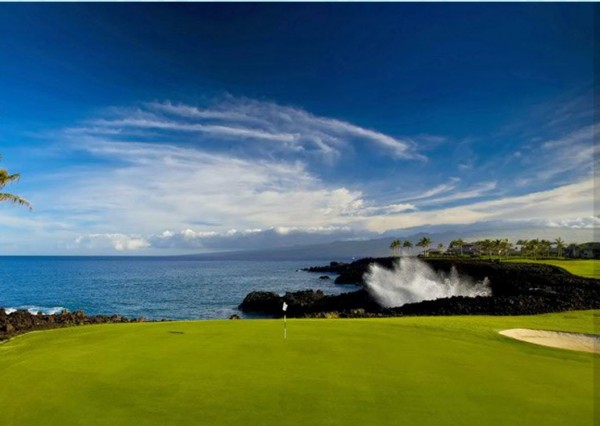
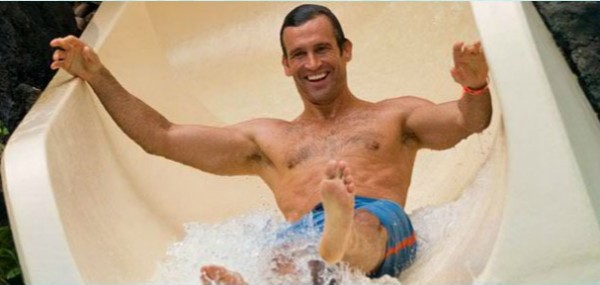
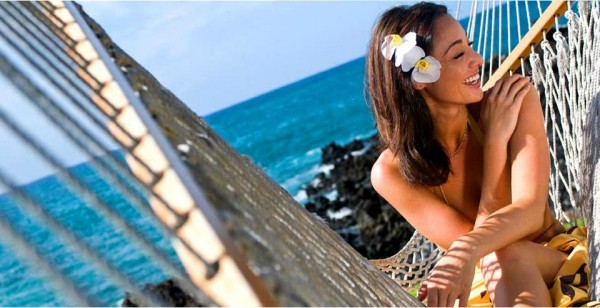
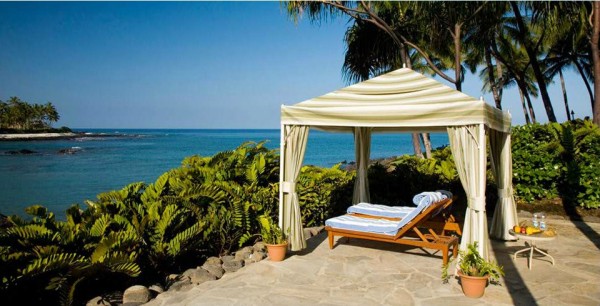
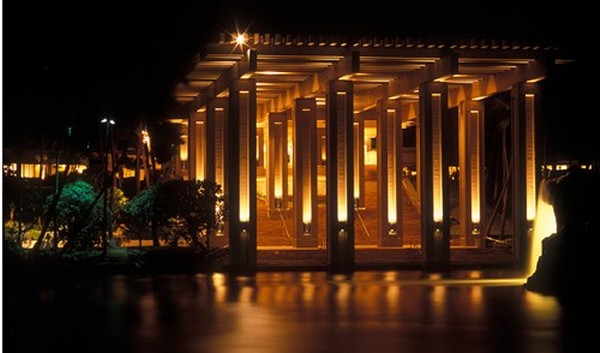
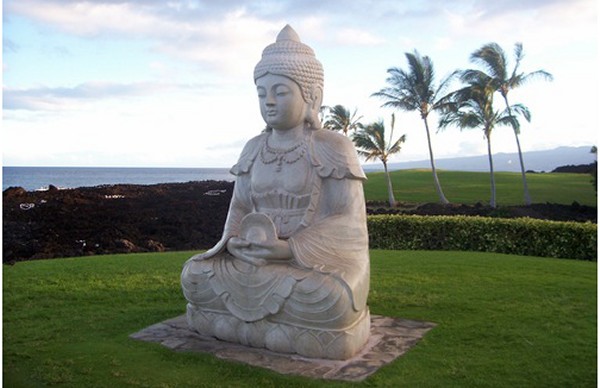
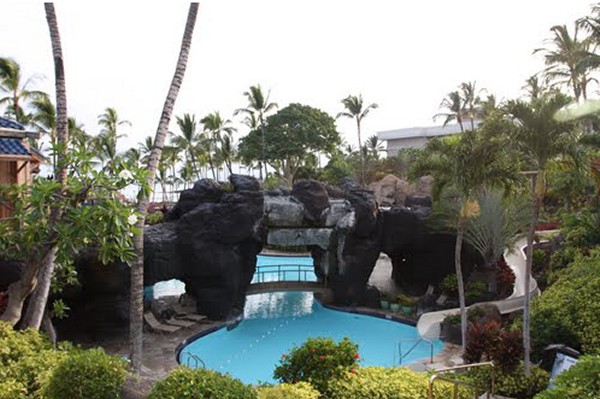
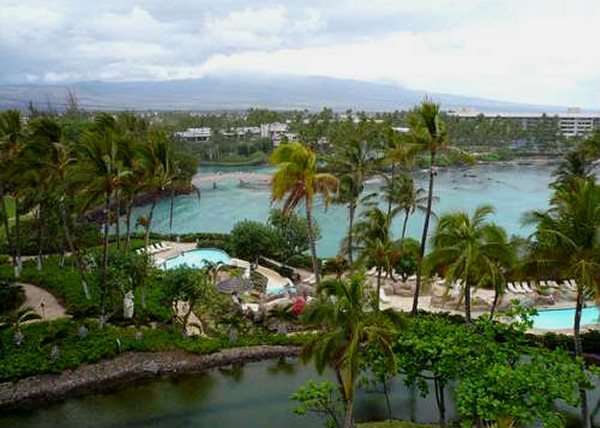
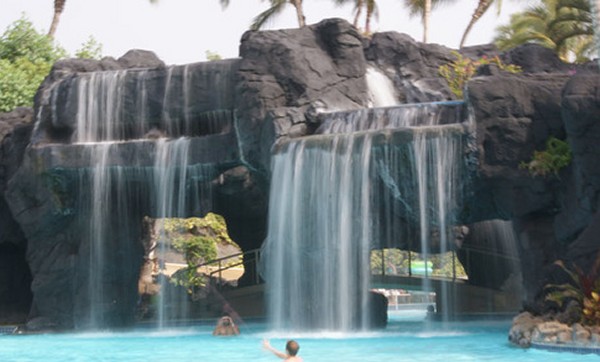

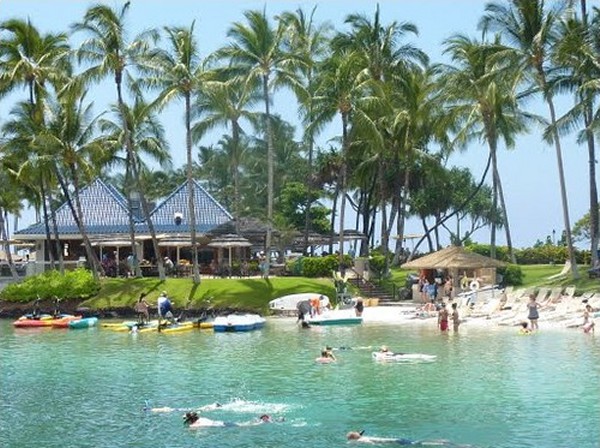
|
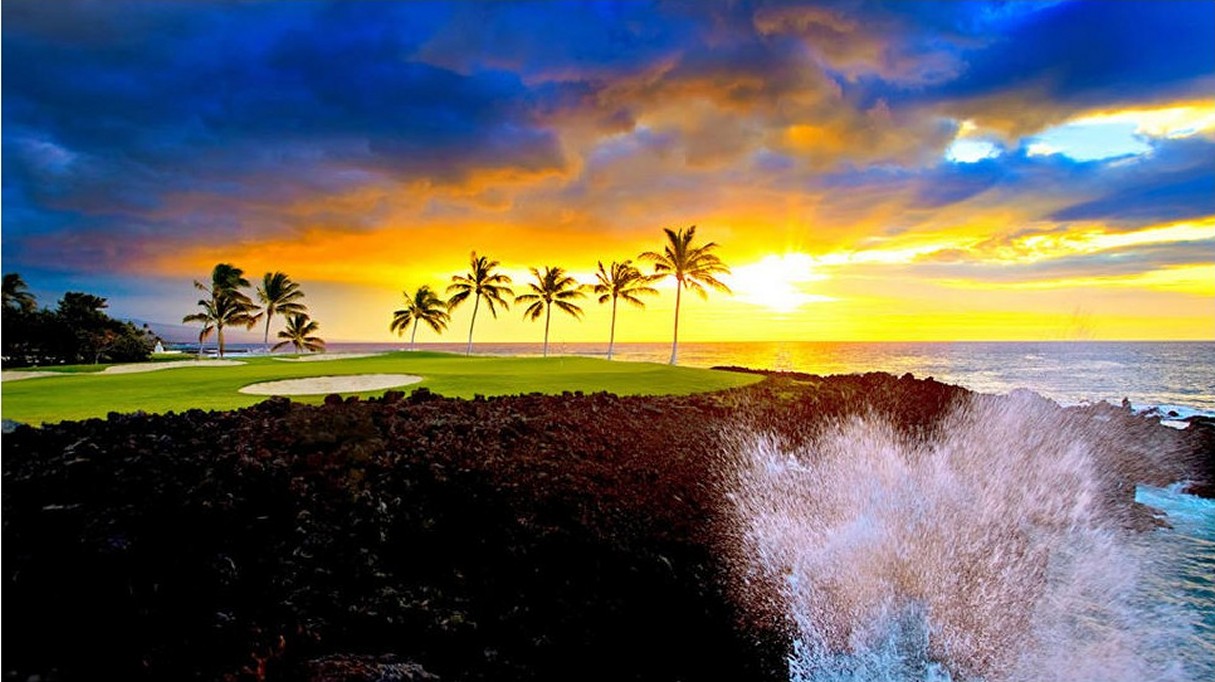 |
|